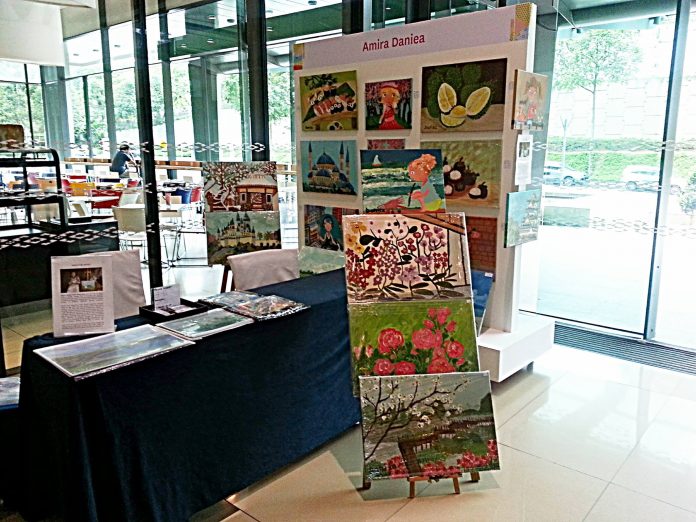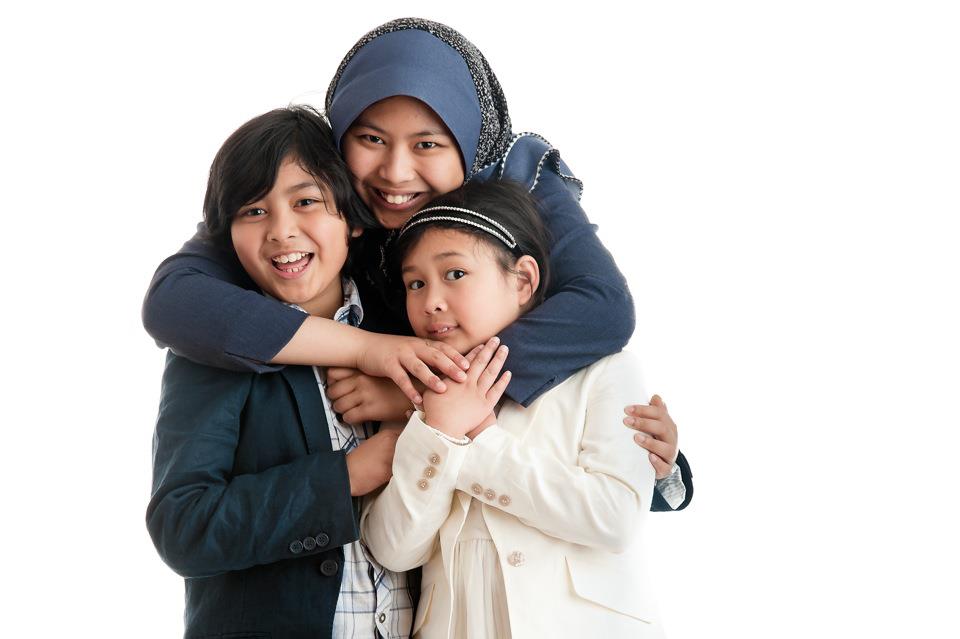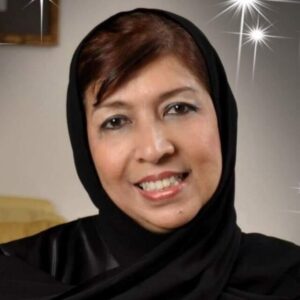

I have noticed that most children under the Autism Spectrum Disorder (ASD) are boys. Occasionally we come across girls who are withdrawn into their own world and when you look at them you can feel a sense of calmness and happiness as they are exactly that.
One such person that I feel such an infinity for is Amira Daniea, the lovely youngest daughter of UKM Medical Centre Anaesthesiologist, Dr Azlina Masdar (Ina). This article was supposed to have been published in April, during Autism Awareness Month, but due to our tight schedule, we can only publish it later. After all, Autism is a lifelong issue and there should not be a cut-off time to propagate more awareness and acceptance until everyone understands what families with Autism offsprings and siblings go through.
Speaking to the New Malaysia Herald which had interviewed Dr Ina earlier, she said that when Daniea was first diagnosed with Autism at the age of two years and three months, she had to stop for a while and wondered if this is one of those tests where you can study as much as you can, but the test questions will still baffle you, and sometimes there are no answers.
“After all, I had studied about Autism in medical school, I have treated patients with Autism, and when you have one of your own, you wonder if you have the capacity to do the best for her,” recalls Dr Ina.
At that time, they were living in Ireland, far from home but thankfully, the facilities and support were available for them to hold Daniea’s hand tightly and take her on this journey that the family was definitely not prepared for.
An Artistic Savant
Today, at 15 years old, Daniea is a happy teenager, an artistic savant, if you can call her that (which mother wouldn’t?), and still only speaking when there is a need to, although in three-worded sentences.
Nevertheless, the journey that got her to this point in her life had let Dr Ina to the school of hard knocks, groping her way through a maze, stopping for a while to take a deep breath, and getting up again to move forward, looking for that miracle that all parents of special needs children seek.
It all began in Ireland in the year 2005 when they moved there in January, when a heavily-pregnant Dr Ina followed her husband who was doing his PhD in Mechanical Engineering and Daniea was born two months later.
Everything seemed in order for the first 18 months of Daniea’s baby development. The only thing that was delayed was her speech. Thus when she reached 18 months for the follow-up, a realization came to her: She was not talking at all, nor was she interacting with any of the family members.
Her ABA therapist aimed for Daniea to absorb all the teachings – behaviour intervention, fine motor skills and speech therapy. She needed four hours of daily therapy and it was an expensive exercise, so Dr Ina had to think whether she should do temporary work so she can be with her for the sessions or do full-time work and pay for the therapists. In the end she decided to take up more overtime hours.
“Blessedly at that time, we found an excellent therapist who did not only conduct behavioural therapy, but speech, writing, and toilet training as well. Daniea, meanwhile, understood us, but she was still not talking.
“Daniea had to undergo intensive therapies for six months then as there were some goals that we needed to reach. But I was struggling at that time. But that’s the beauty of the early intervention programmes in Ireland. We had a regular educational psychologist, regular OT sessions – all free and funded by the government.”
When her husband completed his studies three years later, she was not sure whether to remain in Ireland or return to Malaysia. She decided to stay put in Dublin to complete Daniea’s early intervention programme. Apart from Daniea, one of the considerations that they had to look into was her eldest daughter’s education. She was turning 13 at that time and they were torn whether to stay in Dublin or start secondary education in Malaysia.

“But in July 2012, we returned to Malaysia for good. We moved all our things and came back with our hearts full of excitement, yet worried about the unknown after being in our comfort zone in dealing with Autism issues in Dublin.”
Of course, things were different in Malaysia, the facilities and support were still being deliberated upon, but when she reflected back, she said that Allah facilitated their journey with Daniea. Made her stronger, more patient. Allah gave us challenges, but he paved the way for us to look for the solutions, she said.
“They say that there is a fine line between love and despair. But when you have a child with special needs, that line is almost invisible.“ – Dr Azlina Masdar
The Journey Into Artdom
When Daniea was much younger, the family did not really observe her talent in art.
“It all depends on the therapists and the equipment they use. Some wanted us to buy the items ourselves, while others brought the products on their own. And among one of the items one of the therapists used was the magnetic board.”
Most times during lessons, she will have to write her alphabets, but when there is no lesson, she will just draw circles on the board. Then she started drawing people’s faces, then their limbs and torso – ultimately it becomes a whole person. Then she migrated to smiling faces and she seemed happy when she was drawing.
So one of the therapists used her skill in drawing as part of the therapy. Reward concept – once she finishes her task, she gets a reward, either chocolates, drawing or toys.
Then they started rewarding her with books. Started with ladybird books. One of her favourites was Little Miss Sunshine and the Mr Men Series. Hello Kitty and Dora were her other favourites.
Subsequently, she started drawing the characters from the books. These were the easiest. The most difficult was the expressions of the faces. But the teacher taught her how to draw the expressions.
“From when she was four years old, we saw her skill in simple doodling and sketches. That’s how she started with art. But as we wanted her to go to an art centre so that she can learn to socialize we looked and found such a centre that took in kids with special needs. She went there for a year.”
At the beginning, she drew with water colours, but she did not seem happy with water colours as it was not so vibrant.
“Ultimately, I found her a private art teacher that does painting with acrylic. She does it at her house, but the fees were costly. Even for assessment, it was expensive. And her first painting she tried out was a painting of a girl. It was so vibrant, and her choice of colours was good. So we decided to stop at the art centre, but continued with this private centre. It was expensive, but at the end of the day, it was worth it. Her paintings had market value.”

The family wanted to sell the paintings, but a part of her (Dr Ina) wanted to hold on to them. So she thought she could transfer to t-shirts, and the manufacturer also did fridge magnets. And that’s when they launched the KLCC tower and Penyu – tshirts and fridge magnets. They started selling these at Nasom Bazaars for a good cause, the Tabung Nasom Titiwangsa.
“So when we started selling the products, I realized that the paintings were expensive as she had put in a lot of effort in the drawings, thus we could not sell cheaply as it would not be fair on her.
“Then a dear friend suggested that we transfer the drawings onto tudungs. As she has seen these before produced by a production company. We brought four of her designs and transferred these onto tudungs. And I started wearing these tudungs and everyone was just complimenting the pieces.“
However, when it comes to drawings, although she reprinted them into smaller boards and tried to sell as cheaply as possible, the sales were not taking off. So she decided to maintain the production of tudungs and sell these on a large scale. And marketed this as DanieaArt.
All in all, merchandises were Painting, Tshirts, Fridge Magnets, Tudungs and then another idea was Notebooks. But now they just specialize in Tudungs and Notebooks.
“So we started joining the bazaars organized by Autism Café Project. And during these occasions we had reporters interviewing us. She has produced more than 100 drawings thus far.”
Sacrifices, Time, Money And Energy
During this journey, there were a lot of sacrifices, time, energy, thoughts, money. They had to do this for when they are no longer around later. And what if she is unwell later? Thoughts that are always on the minds of Autism parent.
We taught her life skills, and she is now independent, but Dr Ina did not teach her to cook for fear of handling the knife and stove. She does not wash clothes, but she knows how to hang them.
In Malaysia, if we want to go out, there are very limited places. Potential dangers are there and she has limited verbal capability, so she is still dependent on having someone with her.
DanieArt does not bring in that much of an income, but they are doing this more for exposure – drawing and independence. And they keep a tabung (savings fund) for her. But now they want to have a platform for her, like an event in GSC to showcase her paintings. Of course with the COVID-19 pandemic, any ideas are put on hold for the moment. – New Malaysia Herald
About the author: Hasnah Abdul Rahman is the editor-in-chief of the New Malaysia Herald while being an activist for autism. She has worked for various media organisations as reporter and editor and specialises in strategic communications. She is also a foodpreneur in her spare time and gives traditional cuisine that 5-star edge from her home kitchen.

Datin Hasnah is the co-founder and CEO of New Malaysia Herald based in Kuala Lumpur, Malaysia.
With an extensive background in mass communication and journalism, she works on building up New Malaysia Herald and it’s partner sites. A tireless and passionate evangalist, she champions autism studies and support groups.
Datin Hasnah is also the Editor in Chief of New Malaysia Herald.

Facebook Comments